Q1: A 20 MVA, 11.2 kV, 4-pole, 50 Hz alternator has an inertia constant of 15 MJ/MVA. If the input and output powers of the alternator are 15 MW and 10 MW, respectively, the angular acceleration in mechanical degree/s2 is __________. (round off to nearest integer) (2022)
(a) 25
(b) 50
(c) 75
(d) 100
Ans: (c)
Sol: We have, swing equation
 Put the values,
Put the values,

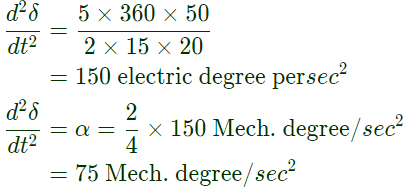
Q2: Two generating units rated for 250 MW and 400 MW have governor speed regulations of 6% and 6.4%, respectively, from no load to full load. Both the generating units are operating in parallel to share a load of 500 MW. Assuming free governor action, the load shared in MW, by the 250 MW generating unit is _________. (round off to nearest integer) (2022)
(a) 100
(b) 150
(c) 200
(d) 250
Ans: (c)
Sol: Let no-load frequency is 50 Hz.
Draw the curve :
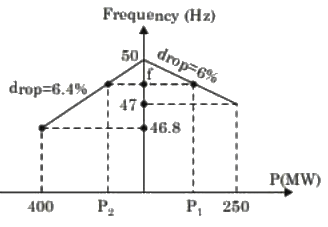 From the curve,
From the curve,
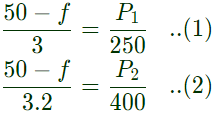 From eq. (1) & (2),
From eq. (1) & (2),
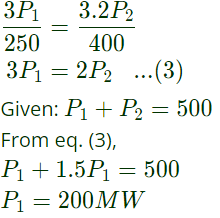
Q3: In the figure shown, self-impedances of the two transmission lines are 1.5j p.u each, and Zm = 0.5jp.u is the mutual impedance. Bus voltages shown in the figure are in p.u. Given that δ > 0, the maximum steady-state real power that can be transferred in p.u from Bus-1 to Bus-2 is (2021)
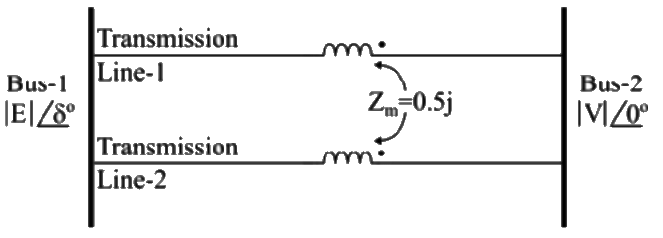 (a) |E| |V|
(a) |E| |V|
(b) (|E| |V|)/2
(c) 2 |E| |V|
(d) (3|E| |V|)/2
Ans: (a)
Sol: 
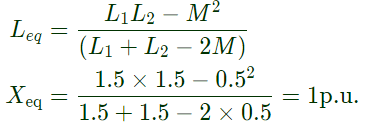
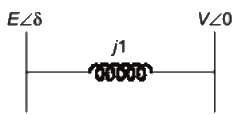

Q4: In the single machine infinite bus system shown below, the generator is delivering the real power of 0.8pu at 0.8 power factor lagging to the infinite bus. The power angle of the generator in degrees (round off to one decimal place) is _________ (2019)
 (a) 12.8
(a) 12.8
(b) 28.4
(c) 20.5
(d) 32.6
Ans: (c)
Sol: 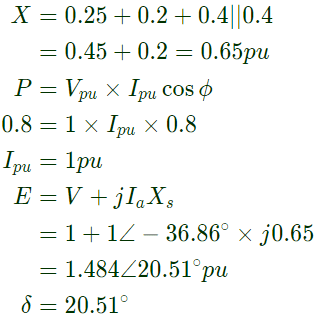
Q5: Consider a lossy transmission line with V1 and V2 as the sending and receiving end voltages, respectively. Z and X are the series impedance and reactance of the line, respectively. The steady-state stability limit for the transmission line will be (2018)
(a) greter than 
(b) less than 
(c) equal to 
(d) equal to 
Ans: (b)
Sol: With only x:
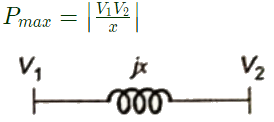 With Lossy Tr, Line
With Lossy Tr, Line

Q6: A 3-phase, 2-pole, 50 Hz, synchronous generator has a rating of 250 MVA, 0.8 pf lagging. The kinetic energy of the machine at synchronous speed is 1000 MJ. The machine is running steadily at synchronous speed and delivering 60 MW power at a power angle of 10 electrical degrees. If the load is suddenly removed, assuming the acceleration is constant for 10 cycles, the value of the power angle after 5 cycles is ________ electrical degrees. (SET-2 (2017))
(a) 1.27
(b) 2.7
(c) 12.7
(d) 127
Ans: (c)
Sol: 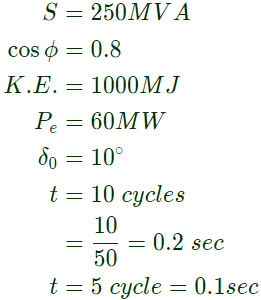 Load is removed,
Load is removed,
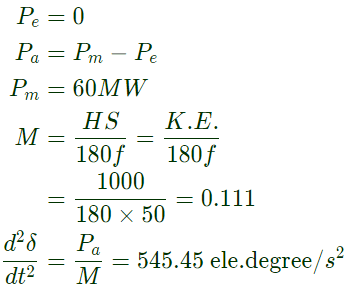
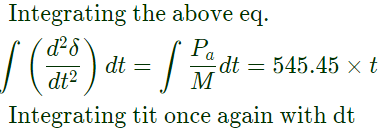
 So, new value of power angle
So, new value of power angle
= 10° + 2.7° = 12.7°
Q7: The figure shows the single line diagram of a power system with a double circuit transmission line. The expression for electrical power is 1.5 sinδ, where δ is the rotor angle. The system is operating at the stable equilibrium point with mechanical power equal to 1 pu. If one of the transmission line circuits is removed, the maximum value of δ as the rotor swings, is 1.221 radian. If the expression for electrical power with one transmission line circuit removed is Pmaxsinδ, the value of Pmax, in pu is _________. (SET-1 (2017))
 (a) 0.729
(a) 0.729
(b) 1.22
(c) 2.6
(d) 4.8
Ans: (b)
Sol: 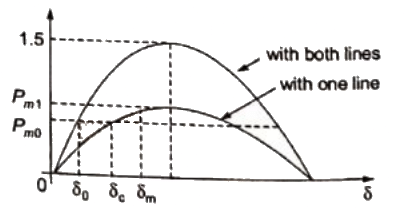 Using equal area criteria:
Using equal area criteria:
 By solving above integration,
By solving above integration,
 Given data:
Given data:
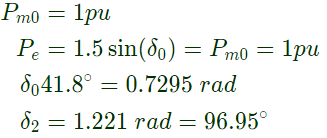 Substitute above values in above equation,
Substitute above values in above equation,

Q8: The synchronous generator shown in the figure is supplying active power to an infinite bus via two short, lossless transmission lines, and is initially in steady state. The mechanical power input to the generator and the voltage magnitude E are constant. If one line is tripped at time t1 by opening the circuit breakers at the two ends (although there is no fault), then it is seen that the generator undergoes a stable transient. Which one of the following waveforms of the rotor angle δδ shows the transient correctly? (SET-2 (2015))
 (a)
(a) 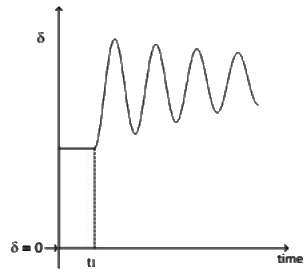 (b)
(b) 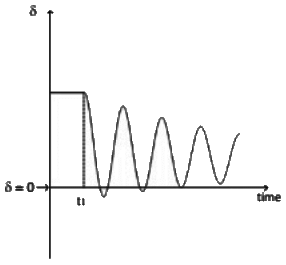 (c)
(c) 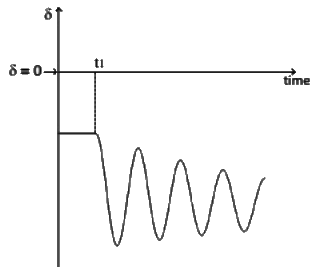 (d)
(d) 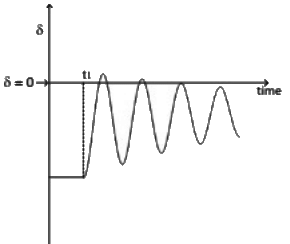 Ans: (a)
Ans: (a)
Sol: Initial value of δ = δ0 at t = t1 with both lines are in service of one of the line circuit breakes opened the δ is increased for same time and stabilizes to new value of δ.
Q9: A 50 Hz generating unit has H-constant of 2 MJ/MVA. The machine is initially operating in steady state at synchronous speed, and producing 1 pu of real power. The initial value of the rotor angle δ is 5°, when a bolted three phase to ground short circuit fault occurs at the terminal of the generator. Assuming the input mechanical power to remain at 1 pu, the value of δ in degrees, 0.02 second after the fault is _________. (SET-1 (2015))
(a) 0.5
(b) 2.8
(c) 4.2
(d) 5.9
Ans: (d)
Sol: Let 3 − ϕ fault occurs at t = 0
 Now, swing equation for t ≥ 0+
Now, swing equation for t ≥ 0+
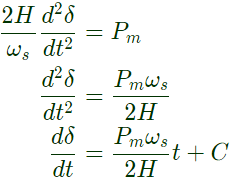

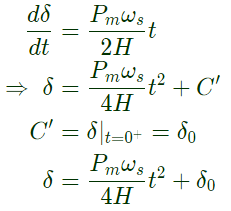 Now in problem,
Now in problem,


Q10: The figure shows the single line diagram of a single machine infinite bus system.
 The inertia constant of the synchronous generator H = 5 MW-s/MVA. Frequency is 50 Hz. Mechanical power is 1 pu. The system is operating at the stable equilibrium point with rotor angle δ equal to 30°. A three phase short circuit fault occurs at a certain location on one of the circuits of the double circuit transmission line. During fault, electrical power in pu is Pmax sin δ . If the values of δ and dδ/dt at the instant of fault clearing are 45° and 3.762 radian/s respectively, then Pmax (in pu) is ______. (SET-3 (2014))
The inertia constant of the synchronous generator H = 5 MW-s/MVA. Frequency is 50 Hz. Mechanical power is 1 pu. The system is operating at the stable equilibrium point with rotor angle δ equal to 30°. A three phase short circuit fault occurs at a certain location on one of the circuits of the double circuit transmission line. During fault, electrical power in pu is Pmax sin δ . If the values of δ and dδ/dt at the instant of fault clearing are 45° and 3.762 radian/s respectively, then Pmax (in pu) is ______. (SET-3 (2014))
(a) 0.11
(b) 0.23
(c) 0.48
(d) 0.64
Ans: (b)
Sol: 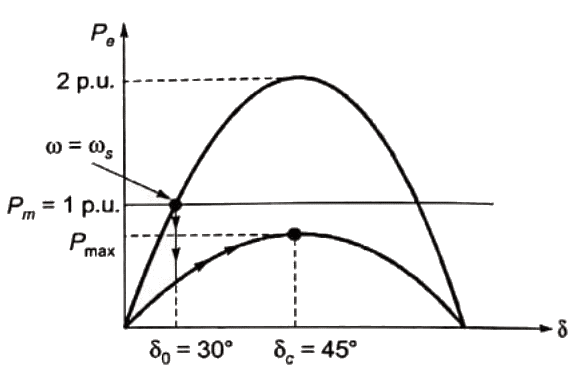
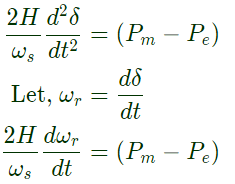 Multiplying with ωr in both side
Multiplying with ωr in both side
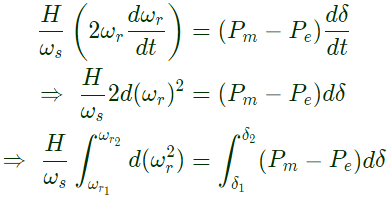

 In problem,
In problem,
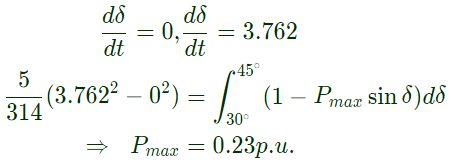
Q11: There are two generators in a power system. No-load frequencies of the generators are 51.5 Hz and 51 Hz, respectively, and both are having droop constant of 1Hz/MW. Total load in the system is 2.5 MW. Assuming that the generators are operating under their respective droop characteristics, the frequency of the power system in Hz in the steady state is ______. (SET-2 (2014))
(a) 25
(b) 50
(c) 75
(d) 100
Ans: (b)
Sol: Let no-load frequency of generator-1 be 51.5 Hz and no-load frequency of generator-2 be 51 Hz.
Given total load = 2.5 Mwand drop of both machines = 1 Hz/MW
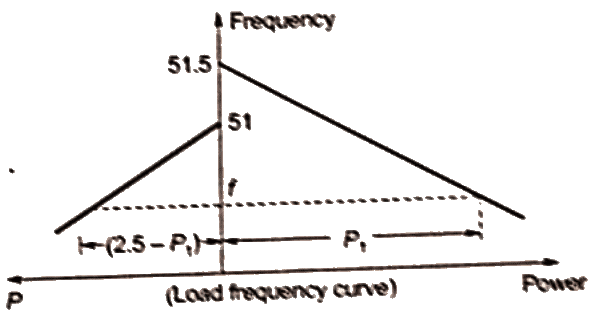 Let machine-1 shares a load of P1 MW them machine-2 will share a load of (2.5 − P1) MW
Let machine-1 shares a load of P1 MW them machine-2 will share a load of (2.5 − P1) MW
Le the steady state frequency of the system be f.
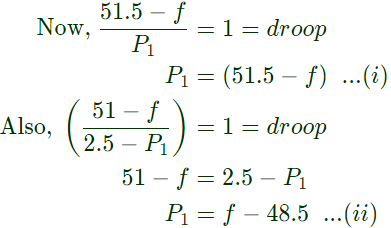
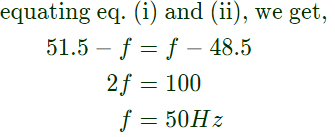
Q12: A synchronous generator is connected to an infinite bus with excitation voltage Ef = 1.3 pu. The generator has a synchronous reactance of 1.1 pu and is delivering real power (P) of 0.6 pu to the bus. Assume the infinite bus voltage to be 1.0 pu. Neglect stator resistance. The reactive power (Q) in pu supplied by the generator to the bus under this condition is _____. (SET-2 (2014))
(a) 0.8
(b) 0.11
(c) 0.45
(d) 1.82
Ans: (b)
Sol: Given, 
Neglecting stator resistance i.e. θs = 90°
Output power delivered,
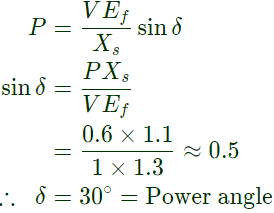
 Reactive power is given by,
Reactive power is given by,
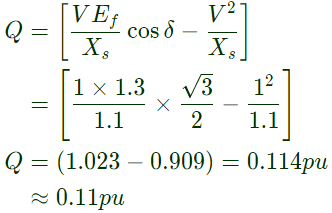
Q13: A cylinder rotor generator delivers 0.5 pu power in the steady-state to an infinite bus through a transmission line of reactance 0.5 pu. The generator no-load voltage is 1.5 pu and the infinite bus voltage is 1 pu. The inertia constant of the generator is 5MW-s/MVA and the generator reactance is 1 pu. The critical clearing angle, in degrees, for a three-phase dead short circuit fault at the generator terminal is (2012)
(a) 53.5
(b) 60.2
(c) 70.8
(d) 79.6
Ans: (d)
Sol: 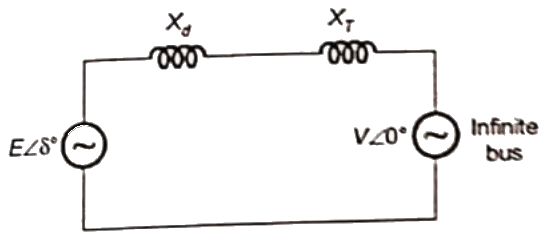
 Critical clearing angle
Critical clearing angle

Q14: A 500 MW, 21 kV, 50 Hz, 3-phase, 2-pole synchronous generator having a rated p.f = 0.9, has a moment of inertia of 27.5 × 103kg − m2. The inertia constant (H) will be (2009)
(a) 2.44s
(b) 2.71s
(c) 4.88s
(d) 5.42s
Ans: (a)
Sol: J = moment of inertia = 27.5 × 103kg − m2
Synchronous speed

Kinetic energy of the rotor
 K.E. = 1375 MJ
K.E. = 1375 MJ
G = Machine rating 
Inertia constant 
Q15: A loss less single machine infinite bus power system is shown below :
 The synchronous generator transfers 1.0 per unit of power to the infinite bus. The critical clearing time of circuit breaker is 0.28 s. If another identical synchronous generator is connected in parallel to the existing generator and each generator is scheduled to supply 0.5 per unit of power, then the critical clearing time of the circuit breaker will (2008)
The synchronous generator transfers 1.0 per unit of power to the infinite bus. The critical clearing time of circuit breaker is 0.28 s. If another identical synchronous generator is connected in parallel to the existing generator and each generator is scheduled to supply 0.5 per unit of power, then the critical clearing time of the circuit breaker will (2008)
(a) reduce to 0.14 s
(b) reduce but will be more than 0.14 s
(c) remain constant at 0.28 s
(d) increase beyond 0.28 s
Ans: (d)
Sol: 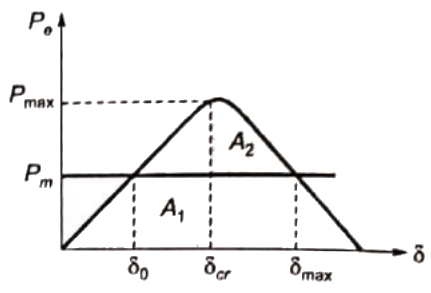 For such faults,
For such faults,
δcr is given by
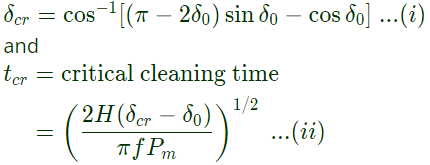 CASE-1:
CASE-1:
When only once generator is connected
Mechanical input to the generator  = Electrical power delivered by the generator
= Electrical power delivered by the generator 
 CASE-2:
CASE-2:
When two generator connected in parallel
Electrical power delivered by each generator

Mechanical inout to each generator
 Assuming δ0 in each case same
Assuming δ0 in each case same
 So, δcr will also be same in both cases, (from equation (i)),
So, δcr will also be same in both cases, (from equation (i)),
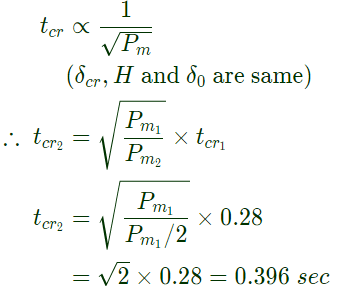
 Put the values,
Put the values,

 From the curve,
From the curve, From eq. (1) & (2),
From eq. (1) & (2),
 (a) |E| |V|
(a) |E| |V|



 (a) 12.8
(a) 12.8




 With Lossy Tr, Line
With Lossy Tr, Line
 Load is removed,
Load is removed,

 So, new value of power angle
So, new value of power angle (a) 0.729
(a) 0.729 Using equal area criteria:
Using equal area criteria: By solving above integration,
By solving above integration, Given data:
Given data: Substitute above values in above equation,
Substitute above values in above equation,
 (a)
(a)  (b)
(b)  (c)
(c)  (d)
(d)  Ans: (a)
Ans: (a) Now, swing equation for t ≥ 0+
Now, swing equation for t ≥ 0+

 Now in problem,
Now in problem,

 The inertia constant of the synchronous generator H = 5 MW-s/MVA. Frequency is 50 Hz. Mechanical power is 1 pu. The system is operating at the stable equilibrium point with rotor angle δ equal to 30°. A three phase short circuit fault occurs at a certain location on one of the circuits of the double circuit transmission line. During fault, electrical power in pu is Pmax sin δ . If the values of δ and dδ/dt at the instant of fault clearing are 45° and 3.762 radian/s respectively, then Pmax (in pu) is ______. (SET-3 (2014))
The inertia constant of the synchronous generator H = 5 MW-s/MVA. Frequency is 50 Hz. Mechanical power is 1 pu. The system is operating at the stable equilibrium point with rotor angle δ equal to 30°. A three phase short circuit fault occurs at a certain location on one of the circuits of the double circuit transmission line. During fault, electrical power in pu is Pmax sin δ . If the values of δ and dδ/dt at the instant of fault clearing are 45° and 3.762 radian/s respectively, then Pmax (in pu) is ______. (SET-3 (2014))
 Multiplying with ωr in both side
Multiplying with ωr in both side

 In problem,
In problem,
 Let machine-1 shares a load of P1 MW them machine-2 will share a load of (2.5 − P1) MW
Let machine-1 shares a load of P1 MW them machine-2 will share a load of (2.5 − P1) MW



 Reactive power is given by,
Reactive power is given by,

 Critical clearing angle
Critical clearing angle

 K.E. = 1375 MJ
K.E. = 1375 MJ

 The synchronous generator transfers 1.0 per unit of power to the infinite bus. The critical clearing time of circuit breaker is 0.28 s. If another identical synchronous generator is connected in parallel to the existing generator and each generator is scheduled to supply 0.5 per unit of power, then the critical clearing time of the circuit breaker will (2008)
The synchronous generator transfers 1.0 per unit of power to the infinite bus. The critical clearing time of circuit breaker is 0.28 s. If another identical synchronous generator is connected in parallel to the existing generator and each generator is scheduled to supply 0.5 per unit of power, then the critical clearing time of the circuit breaker will (2008) For such faults,
For such faults, CASE-1:
CASE-1: = Electrical power delivered by the generator
= Electrical power delivered by the generator 
 CASE-2:
CASE-2:
 Assuming δ0 in each case same
Assuming δ0 in each case same So, δcr will also be same in both cases, (from equation (i)),
So, δcr will also be same in both cases, (from equation (i)),





















